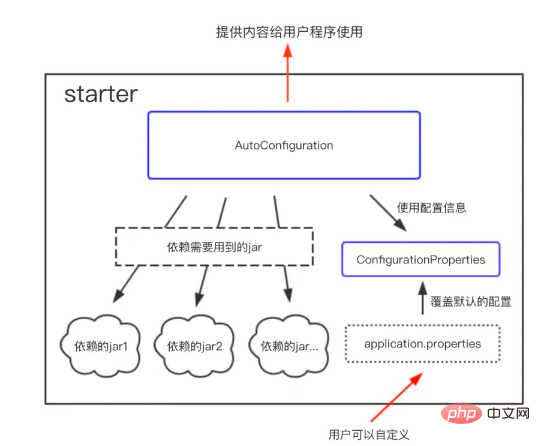Spring Boot Starter是什么?
Spring Boot Starter 是在 SpringBoot 组件中被提出来的一种概念、简化了很多烦琐的配置、通过引入各种 Spring Boot Starter 包可以快速搭建出一个项目的脚手架。
比如我们经常用的一些:
spring-boot-starter-web:
spring-boot-starter-data-redis:
spring-boot-starter-data-mongodb:
spring-boot-starter-data-jpa:
spring-boot-starter-activemq:
总体来说就是 starter 是一种对依赖的合成。
以前传统的做法
在没有 starter 之前,传统的SSM项目、假如我想要在 Spring 中使用 jpa,可能需要做以下操作:
首先在 Maven 中引入使用的数据库的依赖>>然后引入 jpa 的依赖>>在xml中配置一些属性信息>>调试调用直到可以正常运行。
上面这样的操作会有一些问题、比如:
如果过程比较繁琐,这样一步步操作会增加出错的可能性。
在配置的时候也会划掉大量的时间、对于新手和小白不太友好。
使用 Spring Boot Starter 之后
starter 的主要目的就是为了解决上面的这些问题
starter 的理念:
starter 会把所有用到的依赖都给包含进来,避免了开发者自己去引入依赖所带来的麻烦。需要注意的是不同的 starter 是为了解决不同的依赖,所以它们内部的实现可能会有很大的差异,例如 jpa 的 starter 和 Redis 的 starter 可能实现就不一样,这是因为 starter 的本质在于 synthesize,这是一层在逻辑层面的抽象,也许这种理念有点类似于 Docker,因为它们都是在做一个 “包装” 的操作,如果你知道 Docker 是为了解决什么问题的,也许你可以用 Docker 和 starter 做一个类比。
starter 的实现:
虽然不同的 starter 实现起来各有差异,但是他们基本上都会使用到两个相同的内容:ConfigurationProperties 和 AutoConfiguration。因为 Spring Boot 坚信 “约定大于配置” 这一理念,所以我们使用 ConfigurationProperties 来保存我们的配置,并且这些配置都可以有一个默认值,即在我们没有主动覆写原始配置的情况下,默认值就会生效,这在很多情况下是非常有用的。除此之外,starter 的 ConfigurationProperties 还使得所有的配置属性被聚集到一个文件中(一般在 resources 目录下的 application.properties),这样我们就告别了 Spring 项目中 XML 地狱。

上面的 starter 依赖的 jar 和我们自己手动配置的时候依赖的 jar 并没有什么不同,所以我们可以认为 starter 其实是把这一些繁琐的配置操作交给了自己,而把简单交给了用户。除了帮助用户去除了繁琐的构建操作,在 “约定大于配置” 的理念下,ConfigurationProperties 还帮助用户减少了无谓的配置操作。并且因为application.properties文件的存在,即使需要自定义配置,所有的配置也只需要在一个文件中进行,使用起来非常方便。采用的starter都上面都给大家列出来了。
创建Spring Boot Starter步骤
创建starter 项目
创建ConfigurationProperties 用来保存配置信息
创建AutoConfiguration,引用定义好的配置信息
在 AutoConfiguration 实现所有 starter 应该完成的操作,并且把这个类加入 spring.factories 配置文件中进行声明
打包项在 SpringBoot 项目中引入该项目依赖,然后就可以使用该 starter 了
具体操作步骤:
在idea新建一个starter项目、直接执行下一步即可生成项目。

在xml中加入如下配置文件:
<?xml version="1.0" encoding="UTF-8"?>
<project xmlns="http://maven.apache.org/POM/4.0.0"
xmlns:xsi="http://www.w3.org/2001/XMLSchema-instance"
xsi:schemaLocation="http://maven.apache.org/POM/4.0.0 http://maven.apache.org/xsd/maven-4.0.0.xsd">
<modelVersion>4.0.0</modelVersion>
<artifactId>http-starter</artifactId>
<version>0.0.1-SNAPSHOT</version>
<!-- 自定义starter都应该继承自该依赖 -->
<!-- 如果自定义starter本身需要继承其它的依赖,可以参考 https://stackoverflow.com/a/21318359 解决 -->
<parent>
<groupId>org.springframework.boot</groupId>
<artifactId>spring-boot-starters</artifactId>
<version>1.5.2.RELEASE</version>
</parent>
<dependencies>
<!-- 自定义starter依赖此jar包 -->
<dependency>
<groupId>org.springframework.boot</groupId>
<artifactId>spring-boot-starter</artifactId>
</dependency>
<!-- lombok用于自动生成get、set方法 -->
<dependency>
<groupId>org.projectlombok</groupId>
<artifactId>lombok</artifactId>
<version>1.16.10</version>
</dependency>
</dependencies>
</project>创建 proterties 类来保存配置信息
@ConfigurationProperties(prefix = "http")
@Getter
public class HttpProperties {
// 如果配置文件中配置了http.url属性,则该默认属性会被覆盖
private String url = "https://blog.csdn.net/weixin_39709134?type=blog";
}创建业务类:
@Setter
@Getter
public class HttpClient {
private String url;
// 根据url获取网页数据
public String getHtml() {
try {
URL url = new URL(this.url);
URLConnection urlConnection = url.openConnection();
BufferedReader br = new BufferedReader(new InputStreamReader(urlConnection.getInputStream(), "utf-8"));
String line = null;
StringBuilder sb = new StringBuilder();
while ((line = br.readLine()) != null) {
sb.append(line).append("\n");
}
return sb.toString();
} catch (Exception e) {
e.printStackTrace();
}
return "error";
}
}这个业务类包含了url属性和一个getHtml方法,用于获取一个网页HTML 数据
创建 AutoConfiguration
@Configuration
@EnableConfigurationProperties(HttpProperties.class)
public class HttpAutoConfiguration {
@Resource
private HttpProperties properties; // 使用配置
// 在Spring上下文中创建一个对象
@Bean
@ConditionalOnMissingBean
public HttpClient init() {
HttpClient client = new HttpClient();
String url = properties.getUrl();
client.setUrl(url);
return client;
}
}在上面的 AutoConfiguration 中我们实现了自己要求:在 Spring 的上下文中创建了一个 HttpClient 类的 bean,并且我们把 properties 中的一个参数赋给了该 bean。
最后,我们在resources文件夹下新建目录META-INF,在目录中新建spring.factories文件,并且在spring.factories中配置 AutoConfiguration:
org.springframework.boot.autoconfigure.EnableAutoConfiguration=\ com.nosuchfield.httpstarter.HttpAutoConfiguration
最后使用 Maven 打包该项目。之后创建一个 SpringBoot 项目,在项目中添加我们之前打包的 starter 作为依赖,然后使用 SringBoot 来运行我们的 starter
测试如下:
@Component
public class RunIt {
@Resource
private HttpClient httpClient;
public void hello() {
System.out.println(httpClient.getHtml());
}
}
之后可以在 application.properties中修改配置来进行测试证明 properties 中的数据确实被覆盖
以上是SpringCloud-Spring Boot Starter使用测试实例分析的详细内容。更多信息请关注PHP中文网其他相关文章!
 如何将Maven或Gradle用于高级Java项目管理,构建自动化和依赖性解决方案?Mar 17, 2025 pm 05:46 PM
如何将Maven或Gradle用于高级Java项目管理,构建自动化和依赖性解决方案?Mar 17, 2025 pm 05:46 PM本文讨论了使用Maven和Gradle进行Java项目管理,构建自动化和依赖性解决方案,以比较其方法和优化策略。
 如何使用适当的版本控制和依赖项管理创建和使用自定义Java库(JAR文件)?Mar 17, 2025 pm 05:45 PM
如何使用适当的版本控制和依赖项管理创建和使用自定义Java库(JAR文件)?Mar 17, 2025 pm 05:45 PM本文使用Maven和Gradle之类的工具讨论了具有适当的版本控制和依赖关系管理的自定义Java库(JAR文件)的创建和使用。
 如何使用咖啡因或Guava Cache等库在Java应用程序中实现多层缓存?Mar 17, 2025 pm 05:44 PM
如何使用咖啡因或Guava Cache等库在Java应用程序中实现多层缓存?Mar 17, 2025 pm 05:44 PM本文讨论了使用咖啡因和Guava缓存在Java中实施多层缓存以提高应用程序性能。它涵盖设置,集成和绩效优势,以及配置和驱逐政策管理最佳PRA
 如何将JPA(Java持久性API)用于具有高级功能(例如缓存和懒惰加载)的对象相关映射?Mar 17, 2025 pm 05:43 PM
如何将JPA(Java持久性API)用于具有高级功能(例如缓存和懒惰加载)的对象相关映射?Mar 17, 2025 pm 05:43 PM本文讨论了使用JPA进行对象相关映射,并具有高级功能,例如缓存和懒惰加载。它涵盖了设置,实体映射和优化性能的最佳实践,同时突出潜在的陷阱。[159个字符]
 Java的类负载机制如何起作用,包括不同的类载荷及其委托模型?Mar 17, 2025 pm 05:35 PM
Java的类负载机制如何起作用,包括不同的类载荷及其委托模型?Mar 17, 2025 pm 05:35 PMJava的类上载涉及使用带有引导,扩展程序和应用程序类负载器的分层系统加载,链接和初始化类。父代授权模型确保首先加载核心类别,从而影响自定义类LOA


热AI工具

Undresser.AI Undress
人工智能驱动的应用程序,用于创建逼真的裸体照片

AI Clothes Remover
用于从照片中去除衣服的在线人工智能工具。

Undress AI Tool
免费脱衣服图片

Clothoff.io
AI脱衣机

AI Hentai Generator
免费生成ai无尽的。

热门文章

热工具

DVWA
Damn Vulnerable Web App (DVWA) 是一个PHP/MySQL的Web应用程序,非常容易受到攻击。它的主要目标是成为安全专业人员在合法环境中测试自己的技能和工具的辅助工具,帮助Web开发人员更好地理解保护Web应用程序的过程,并帮助教师/学生在课堂环境中教授/学习Web应用程序安全。DVWA的目标是通过简单直接的界面练习一些最常见的Web漏洞,难度各不相同。请注意,该软件中

VSCode Windows 64位 下载
微软推出的免费、功能强大的一款IDE编辑器

SublimeText3 Linux新版
SublimeText3 Linux最新版

Atom编辑器mac版下载
最流行的的开源编辑器

SublimeText3汉化版
中文版,非常好用






